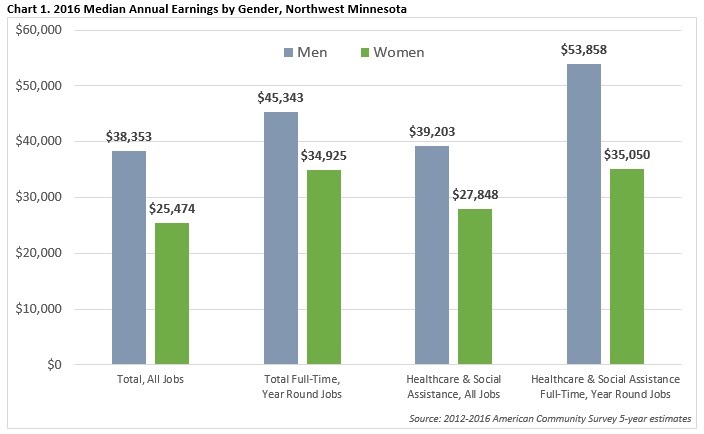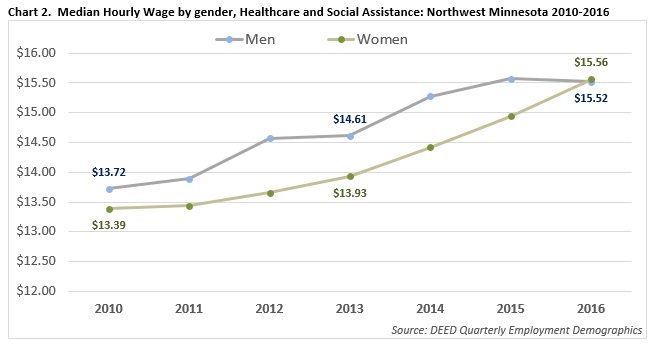 The presence of such industry powerhouses as Polaris, Arctic Cat and New Flyer make Northwest Minnesota a hub of transportation equipment manufacturing.
The presence of such industry powerhouses as Polaris, Arctic Cat and New Flyer make Northwest Minnesota a hub of transportation equipment manufacturing.
From wheat and potatoes to soybeans and sugar beets, the region is a major producer and processor of food staples and specialty agricultural products.
Want the freshest data delivered by email? Subscribe to our regional newsletters.
2/27/2018 12:04:56 PM
Chet Bodin
In 2017, both WalletHub and the Institute on Women's Policy Research came to the same conclusion: Minnesota is the best state for women to live and work. They cite several reasons for the distinction, including economic and social well-being and health and safety; but despite that, data shows that a stubborn gender wage gap persists across the state. According to the Census Bureau's American Community Survey, women in Minnesota have median incomes approximately 71 percent of what men earn, ranging from 51 percent in agriculture, forestry, fishing and hunting to 89 percent in real estate and rental and leasing. Overall, the gender wage gap is even larger in Northwest Minnesota, where the earnings ratio was approximately 66 percent in 2016. Of course, without accounting for hours worked, age or education levels, these results lack some context.
Recently, DEED published a statewide study of the gender wage gap in Minnesota Economic Trends, which took these variables into account. Focusing on health care and social assistance, which is also the leading industry of employment in Northwest Minnesota, our research found the gender wage gap decreased when 'hours worked' was taken into account. On the other hand, the gap increased when adjusting for education levels, suggesting that "women and men employed in health care and social assistance are rewarded differently for the same educational attainment." This month we'll look at whether the same trends exist in Northwest Minnesota, where healthcare is also an influential industry and employs a high number of women.
In Northwest Minnesota, the American Community Survey shows that women's median annual earnings in healthcare and social assistance was 71 percent of those for men in 2016 (Chart 1). Like the statewide study, it would be reasonable to expect the wage gap to decrease when accounting for hours worked. If men worked full-time more often, they would naturally earn more on average than women over time, all else being equal. However, when comparing those who work full-time, year-round, the wage gap increases, with women earning 65 percent of men annually.

Some of this can be explained by the difference in the type of healthcare jobs held by men and women. For example, the ACS shows that over 63 percent of men employed in healthcare occupations work in the highest-earning health diagnosing & treating practitioners category; compared to 42 percent of females (Table 1). Furthermore, females account for 92 percent of those employed in full-time, year-round healthcare support occupations in Northwest.

Whether the difference in jobs is enough to fully explain the gender wage gap in healthcare here is difficult to tell. After all, the healthcare and social assistance industry includes other occupations besides those which are specifically healthcare oriented, such as administrators, maintenance, and even accountants. However, one of DEED's newest data tools, Quarterly Employment Demographics (QED) shows that since the end of the recession, median hourly wages increased faster for women than for men in healthcare and social assistance – so much so, wage rates in the industry were relatively even in 2016 (Chart 2).

While this trend is obviously encouraging, both ACS and QED still show an overall gender pay gap in Northwest Minnesota and statewide. In healthcare and social assistance, one of the most significant industries in Northwest Minnesota that is projected to continue to grow, progress could affect change at multiple economic levels. For employers competing in a tight labor market, steps toward equal pay may help businesses thrive moving forward.
Contact Chet Bodin.